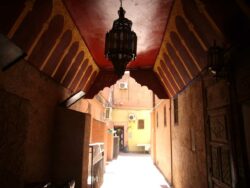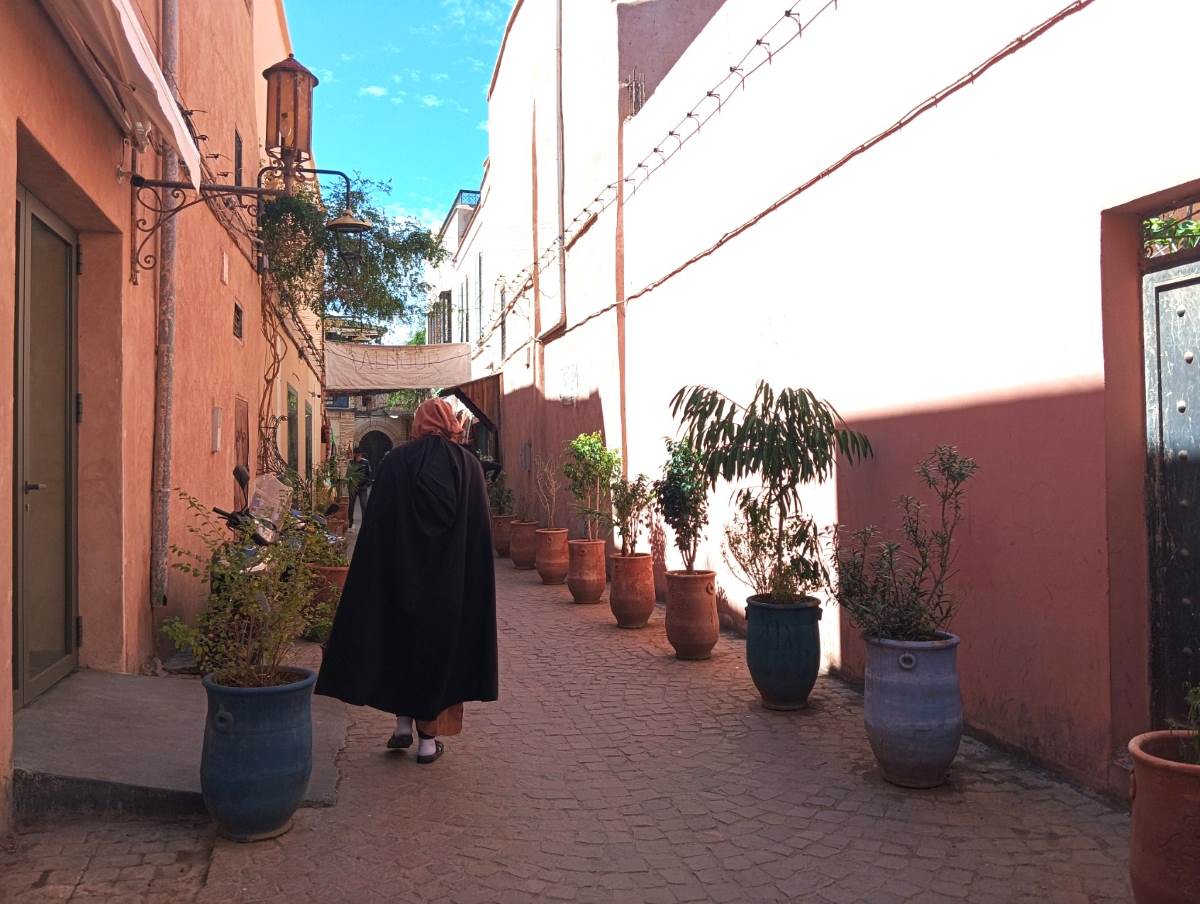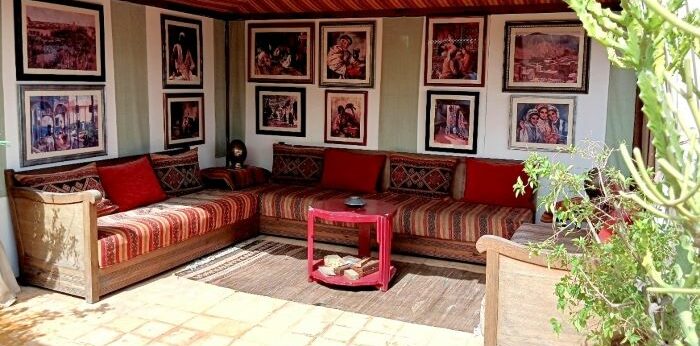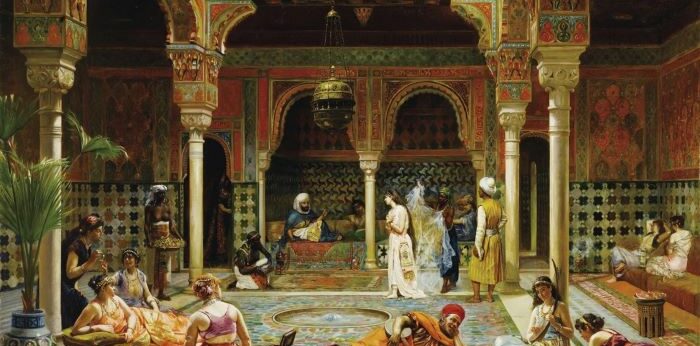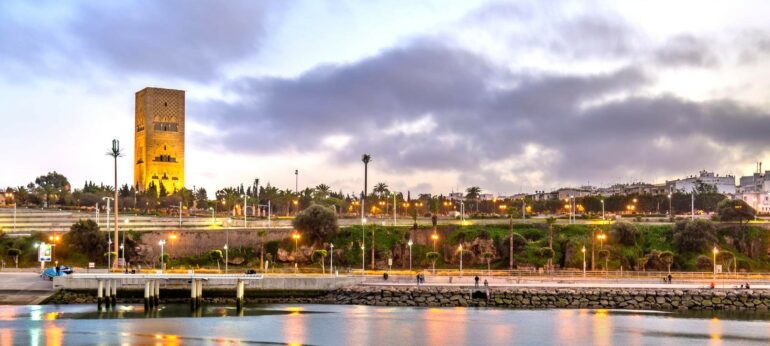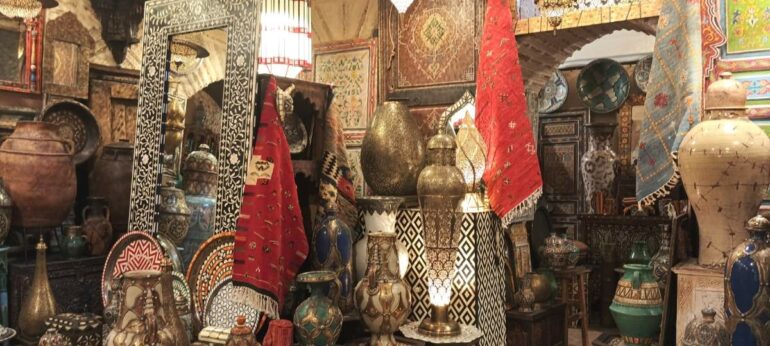The “ochre city”
Each Medina of Morocco has its own character. In the streets of the Medina of Marrakesh, the ochre color is the first thing that jumps out at the visitor. An ochre with shades of red, which earned the city its nickname “Ochre City” or “Red City”. The link to raw earth, the pisé, is therefore constantly reminded to everyone.
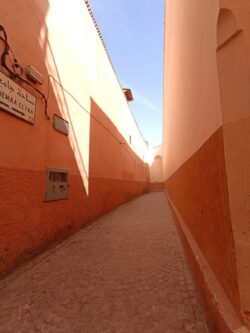
The tourist can also be impressed by the predominance of long and high walls that run along the streets and seem eager to hide the simple houses as well as the mansions with palace-like appearance. This intimacy is hidden from the eyes of visitors. Rare windows pierce the walls, only a few doors sometimes give a signal of the character of the house. Even half-open, we will only see an entrance corridor, which will lead to the open courtyard.
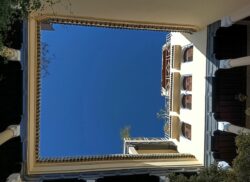
Riad Dar Taliwint
A bit of history
The construction of the Medina of Marrakesh started at the end of the 11th century, decided by the Almoravid ruler Youssef Ben Tachfine who made the city his capital. Its development was quick. Today, it covers 600 hectares and is the most populated in North Africa. Its crenellated ramparts have a perimeter of 10 km and are opened by several doors. Since 1985, it has been listed as a UNESCO World Heritage Site.
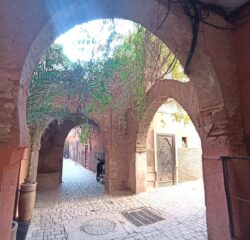
Throughout the history of the Kingdom, Marrakesh has been capital several times, like Fez, Meknes, Rabat. Thus periods of glory and decline are interlinked. The Almohad dynasties (Kasbah, Bab Agnaou, Koutoubia) and Saadians (Saadian Tombs, Medersa Ben Youssef, Badiî Palace) are at the origin of the most emblematic monuments of the city.
The beating heart of this medina is the unmissable Jemaa El Fna Square. Classified by UNESCO as a World Intangible Heritage of Humanity, it comes alive especially in the evening. Walking through it, making your way between the tables of restaurants and the circles (halkas) of happy spectators remains a unique sensory experience.
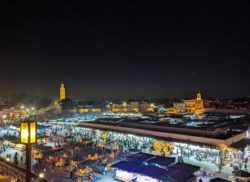
Jemaa El Fna Square
The contours of the famous Square seem circumscribed since the 12th century. First a place for public executions, then for trade and exchanges, it was designated as a “place of spectacle” from the 16th century onwards. Those who today claim that it is a “tourist trap” know nothing about the steps of its evolution and forget that history is stubborn! The place vibrates throughout the year, with or without tourists. The locals are the most addicted to its unique atmosphere.
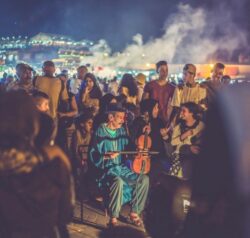
The small Museum of Intangible Heritage on Jemaa El Fna Square, which presents many old documents and films, helps to clarify things!
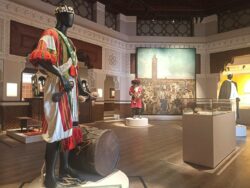
Museum of Intangible Heritage
Emblematic districts
Mellah
The Mellah of Marrakech, the Jewish quarter, seems to have been established in 1558, under the reign of a Saadian Sultan. Located near the Mechouar (the Royal Palace), it becomes one of the main commercial areas of the city and a fortified district, with its doors closed at night. The Mellah, historically, was always a poor or even miserable neighborhood. Until the 1940s, it still has 27,000 city inhabitants.
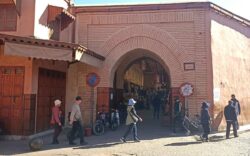
Mellah Entrance
It was the largest Mellah in Morocco, with up to 35,000 residents. At key times, it housed several schools, rabbinic centers and talmudic institutes that have formed many illustrious scholars and rabbis.
By the end of the 1950s, the neighbourhood was gradually being emptied of its residents. Many houses, left vacant after successive departures, were falling into ruin. Thanks to a vast rehabilitation operation, the district benefits from a new craze.
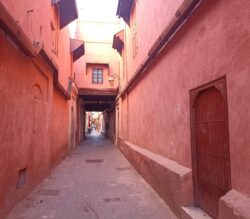
Renamed for a time Essalam («peace») it takes back in 2017 its original name El Mellah, on the instruction of King Mohammed VI who also decides to restore the streets, houses, synagogues and the cemetery.
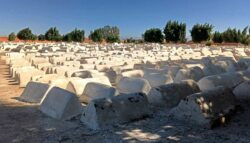
Mellah cemetery
Today’s Mellah attracts many tourists. Sometimes, in search of their roots, Israeli families visit the neighborhood with emotion. Of course, very few descendants currently live there. While the Jewish identity is no longer so dominant, the imprint of culture remains in the specific architecture, and even in today’s trades, activities and shops.
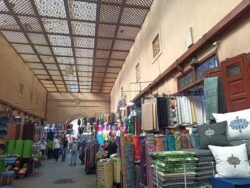
It is a labyrinth of alleys, a small world of contrasts, colors, perfumes. The animation is great between the tiny stalls.
Kasbah
A city in the city ! From the beginning, which dates back to the 12th century, the Kasbah district was like a citadel surrounded by its ramparts and divided by defensive walls. The neighbourhood was completely self-sufficient. Vital goods were stored there. The Almohad dynasty built a palace, emblem of its power, a great mosque and a medersa (school) not to mention the magnificent gate Bab Agnaou.
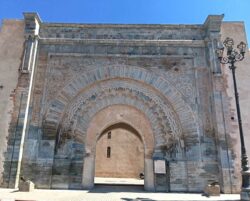
Bab Agnaou
There were also markets, baths, stables, a cemetery, gardens… The Saadian dynasty, in the 16th century enriched and embellished the area by the construction of the splendid Badiî Palace, the restoration and expansion of the mosque, the establishment of the Saadian Tombs.
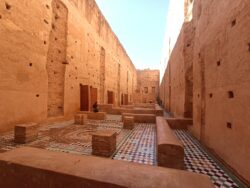
Badiî Palace
The district becomes a showcase of the splendor of this dynasty. Later, powerful notables will build sumptuous mansions. The Kasbah remains a centre of power. Today the traces of these glorious times are still visible with the high walls, the remains of crenellated ramparts, the impressive ruins of the Badiî Palace, the Moulay El Yazid Mosque with its imposing minaret, the site of the Saadian Tombs and even the recent Royal Palace, hidden behind its walls and protected by the Royal Guard.
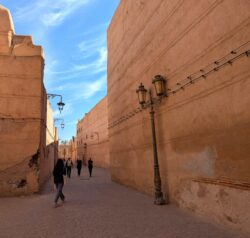
Kasbah district
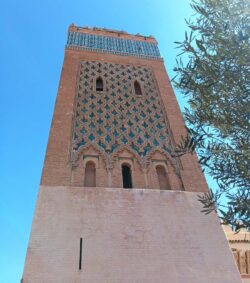
Moulay El Yazid Mosque
Today, walking through the alleys is a journey into that distant past. The market and numerous wholesale stores eventually perpetuate the function of warehouses that the neighborhood used to fulfill. All the ancient monuments are still visible. More recently, the Musée du Monde des Arts de la Parure, which has opened its doors between the Badiî Palace and the Saadian Tombs, is definitely worth a visit.
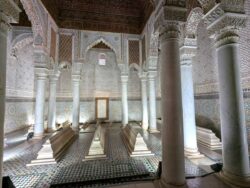
Saadian Tombs

Monde des Arts de la Parure
Riad Zitoun
The districts of Riad Zitoun Jdid (new) and Riad Zitoun Kedim (old) are articulated between two long almost parallel streets that bear the same names. They start at the edge of Mellah and wind up to Jemaa El Fna Square. The district developed greatly from the construction of the Palais Bahia in the late 19th century.
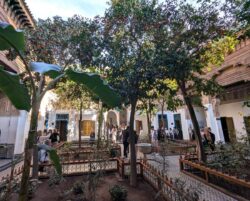
Bahia Palace
Marshal Lyautey established his residence there in 1912. The establishment of French troops naturally contributed to the development of this area, the installation of many foreign residents and the proliferation of businesses.
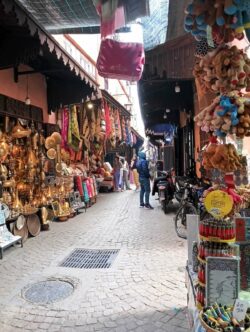
Riad Zitoun Jdid street
These two picturesque streets, extremely lively, are lined with shops, craft shops, restaurants, grocery stores and small local shops. They are like an introduction to the souks. Arches underline the entrances of secondary streets.
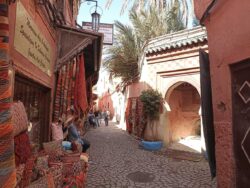
Rue de la Bahia
Riad Zitoun is a residential area which, more recently, has seen the establishment of guest houses in restored riads. In addition to the famous Bahia Palace, there is the magnificent mansion that houses the Dar Si Said Museum dedicated to carpets and weaving. The two main streets are often full of people, but there is tranquillity in the surrounding streets that can be walked around in peace.
Mouassine
This historic district, part of which is embedded in the souks, dates from the 16th and 17th centuries, during the time of the Saadian dynasty. An old Jewish quarter was moved to the Mellah. From 1562, a new urban model developed around the Mouassine Mosque, the water fountain, the hammam and the Koranic school.
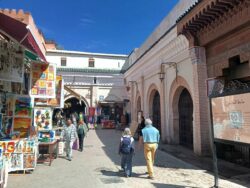
Mouassine Fountain
The layout is still clearly visible. The large walls hide imposing riads with their large courtyard gardens, old residences of notables. The Dar Cherifa (restaurant and cultural venue) and the Ksar Essaoussan (restaurant) are two beautiful examples of rich aristocratic houses from the late 16th century.

Ksar Essaoussan
Nowadays, the main roads and side streets lead to beautiful antique shops, designers of traditional clothes and caftans, trendy cafes and lively restaurants.
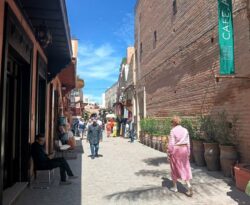
We pass in the souks of dyers, ironmongers, leather craftsmen…
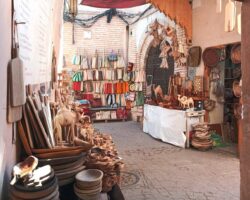
A few steps away are the Museum of Music, the Dar El Bacha Palace (Confluence Museum), and the recently designed Secret Garden.
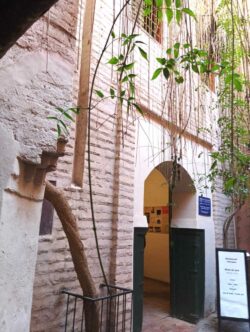
Music Museum
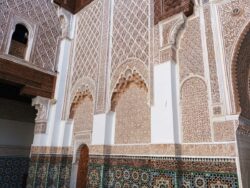
Medersa Ben Youssef
Some foundouks are also restored. These establishments, with a central courtyard and several floors, welcomed the travellers-traders who could store their goods there, deal with their business but also eat and be accommodated. The Medersa Ben Youssef, the House of Photography, the picturesque Place des Epices are also in the neighborhood.
A world in itself…
The vast Medina of Marrakech has many other neighborhoods. A mosque, a hammam and its public oven, a school always determine the perimeter. Their names can evoke a door, a mosque, a saint, an ancient garden, the name of a palace or an illustrious figure. Mention Bab Aylen, Riad Laârous, Dar El Bacha, Kennaria, Bab Doukkala, Derb Dabachi, Ben Saleh, Sidi Ben Slimane El Jazouli, Bab Debbagh, Moukf…
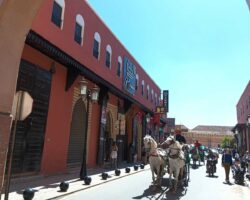
Some popular neighbourhoods have a rough appearance, with no orderly plan.The more residential ones seem to have been designed scrupulously to highlight the elegance of its imposing homes.
The Medinas of Morocco, and particularly that of Marrakech, remain, above all, places of life, exchanges, of trade. The streets have the joy of the colors of the carpets hanging on the walls.
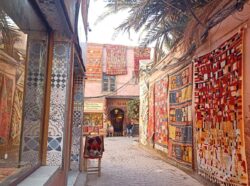
But it is also the Marrakchis (inhabitants of Marrakech), who are so dynamic, sociable, communicative and welcoming, that make their ancient city so fascinating and exciting. The Medina falls asleep quite late and does not wake up very early. Time is different there. This is another aspect of the magic that the ochre city exerts. Every walk in its alleys is a joyful human experience without comparison.
